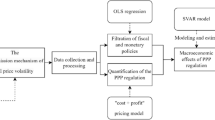Abstract
Petroleum is a kind of fundamental energy resource. Its price fluctuation transmits from upper-stream industry to the lower-stream industry as the production factors price changes. And this leads to the price changes of final consumption. Meantime, due to the cycle of industrial chain, the price changes of lower-stream industry also affect the upper-stream industry in return. This price transmission path is quite complicated. Firstly, it includes both direct and indirect paths; secondly, the transmission process is accompanied with time delay. The traditional input-output price model based on cost-push theory can efficiently solve the first problem when estimating the impact of price fluctuation on the whole price system. However, it neither reflects the dynamic characteristics of price transmission with time nor solves the second problem. To solve this problem, this paper uses the directed weighted network to describe the price transmission among industrial sectors by taking the time-dimension into account, and dynamic price transmission network model is constructed. This model not only describes transmission time delay more accurately, but also calculates the price fluctuation dynamically. On this basis, by utilizing the 2007 Chinese input-output table, this paper conducts empirical analysis on the impact of petroleum price fluctuation on other sectors. The empirical results indicate that the price fluctuation transmission mainly depends on two factors, the price reaction period T k and the consumption relationship with petroleum a ik . 1) If t < T k , then the price change of sector k at period t Δp t k = 0, the petroleum price fluctuation has not transmitted to the sector k, so the price of sector k remains unchanged. 2) If t > T k , then Δp t k > 0, and the greater a ik , the higher price change rate. 3) If t → ∞, it is the same with that in traditional input-output price model. So it can be clearly seen that dynamic price transmission network model is more general than the traditional model, and the traditional model is just an asymptotical special case when time approaches to infinity.
Similar content being viewed by others
References
Duchin F and Lange G, Technological choices and prices and their implications for the US economy 1963–2000, Economic Systems Research, 1992, 4(1): 53–76.
Solow R M, Competitive valuation in a dynamic Leontief model, Econometrica, 1959, 27: 30–53.
Johansen L, On the theory of dynamic input-output models with different time profiles of capital construction and finite life-time of capital equipment, Journal of Economic Theory, 1978, 19: 513–533.
Hawkins D, Some conditions of macroeconomic stability, Econometrica, 1948, 16: 309–322.
Cunado, Juncal, and Perez de Gracia Fernando, Do oil price shocks matter? Evidence for some European countries, Energy Economics, 2003, 25(2): 137–154.
Cunado J and Perez de Gracia F, Oil prices, economic activity and inflation: Evidence for some Asian countries, The Quarterly Review of Economics and Finance, 2005, 45(1): 65–83.
Cologni, Alessandro, and Manera Matteo, Oil prices, inflation and interest rates in a structural cointegrated VAR model for the G-7 countries, Energy Economics, 2008, 30(3): 856–888.
Morishima M, Prices, interest and profits in a dynamic Leontief system, Econometrica, 1958, 26: 358–380.
Zhang H X, The development and improvement on input-output price model, Systems Engineering — Theory & Practice, 2008, 28(1): 40–53 (in Chinese).
Hakan B, Inflationary effect of crude oil prices in Turkey, Departmental Working Papers 0203, Bilkent University, Department of Economics, 2002.
Ren Z P, Pan W Q, and Liu Q Y, Crude oil price effects on China’s price level based on inputoutput price model, 2007, 24(11): 22–28.
Leontief W, Input-Output Analysis, 2nd edition, Oxford University Press, New York, 1986, 55–64.
Zhong Q F, Chen X K, and Liu Q Y, Input-Output Analysis, China Financial and Economic Publishing House, 1993, 79–156 (in Chinese).
Tong R C, The price transmission model considering production delays, The Journal of Quantitative and Technical Economics, 2010, (8): 139–152 (in Chinese).
Kenneth H R, Discrete Mathematics and Its Applications, Fourth Edition, McGraw-Hill Companies, 1998.
Author information
Authors and Affiliations
Corresponding author
Additional information
This research is supported by the National Natural Science Foundation of China under Grant Nos. 71003115 and 70903068, Collaborative Innovation Center, Research Innovation Team Supporting Plan of the Central University of Finance and Economics, Beijing Higher Education Young Elite Teacher Project under Grant No. YETP0964, and the Ministry of Education of Humanities and Social Science Youth Fund Project under Grant No. 11YJC790114.
This paper was recommended for publication by Editor WANG Shouyang.
Rights and permissions
About this article
Cite this article
Liu, Y., Wang, Y. & Qiao, H. Dynamic price model based on transmission delay — Petroleum price fluctuation in China. J Syst Sci Complex 27, 507–523 (2014). https://doi.org/10.1007/s11424-014-3272-9
Received:
Published:
Issue Date:
DOI: https://doi.org/10.1007/s11424-014-3272-9




